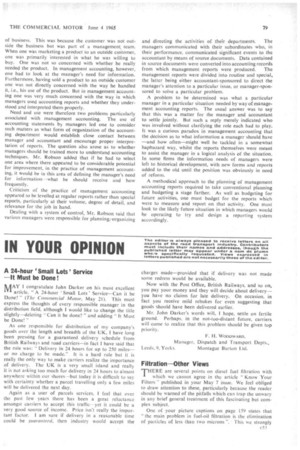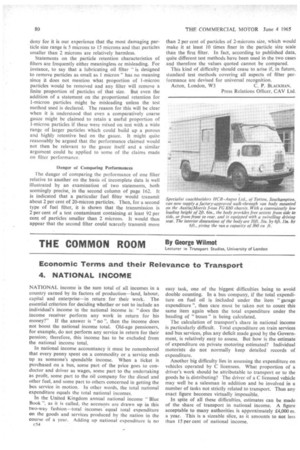IN YOUR OPINION
Page 81

Page 82

If you've noticed an error in this article please click here to report it so we can fix it.
A 24-hour 'Small Lots' Service —It Must be Done!
MAY congratulate John Darker on his most excellent 1" article, A 24-hour Small Lots' Service—Can it be Done? " (The Commercial Motor, May 21). This must express the thoughts of every responsible manager in the distribution field, although I would like to change the title slightly—deleting " Can it be done?" and adding " It Must be Done!"
As one responsible for distribution of my company's goods over the length and breadth of the UK, I have long been pressing for a guaranteed delivery schedule from British Railways and road carriers—in fact I have said that the rule was: Delivery in 24 hours for up to 250 miles— or no charge to be made.' It is a hard rule but it is really the only way to make carriers realize the importance of delivery. The UK is a very small island and really it is not asking too much for delivery in 24 hours to almost anywhere within our shores—but today it is difficult to say with certainty whether a parcel travelling only a few miles will be delivered the next day.
Again as a user of parcels services. I feel that over the past few years there has been a great reluctance amongst carriers to accept this traffic—yet it could be a very good source of income. Price isn't really the important factor. I am sure if delivery in a reasonable time could be guaranteed, then industry would accept the
charges made—provided that if delivery was not made some redress would be available.
Now with the Post Office, British Railways, and so on, you pay your money and they will decide about delivery— you have no claims for late delivery. On occasion, in fact you receive mild rebukes for even suggesting that goods should have been delivered earlier.
Mr. John Darker's words will, I hope, settle on fertile ground. Perhaps, in the not-too-distant future, carriers will come to realize that this problem should be given top priority.
F. H. WooDwAlto, Manager, Dispatch and Transport Depts., Leeds, 9, Yorks. Montague Burton Ltd.
Filtration—Other Views
'THERE are several points on diesel fuel filtration with which we cannot agree in the article " Know Your Filters published in your May 7 issue. We feel obliged to draw attention to these, particularly because the reader should be warned of the pitfalls which can trap the unwary in any brief general treatment of this fascinating but cornplex subject.
One of your picture captions on page 159 states that " the main problem in fuel-oil filtration is the elimination of particles of less than two microns ". This we strongly c53 deny for it is our experience that the most damaging particle size range is 5 microns to 15 microns and that particles smaller than 2 microns are relatively harmless.
Statements on the particle retention characteristics of filters are frequently either meaningless or misleading. For instance, to say that a lubricating oil filter "is designed to remove particles as small as 1 micron" has no meaning since it does not mention what proportion of I-micron particles would be removed and any filter will remove a finite proportion of particles of that size. But even the addition of a statement on the proportional retention for 1-micron particles might be misleading unless the test method used is declared. The reason for this will be clear when it is understood that even a comparatively coarse gauze might be claimed to retain a useful proportion of 1-micron particles if these were mixed on test with a wide range of larger particles which could build up a porous and highly retentive bed on the gauze. It might quite reasonably be argued that the performance claimed would not then be relevant to the gauze itself and a similar argument could be applied to some of the claims made on filter performance.
Danger of Comparing Performances The danger of comparing the performance of one filter relative to another on the basis of incomplete data is well illustrated by an examination of two statements, both seemingly .precise, in the second column of page 162. It is indicated that a particular fuel filter would transmit about 2 per cent of 20-micron particles. Then, for a second type of fuel filter, it is shown that the transmission is 2 per cent of a test contaminant containing at least 92 per cent of particles smaller than 2 microns. It would thus appear that the second filter could scarcely transmit more than 2 per cent of particles of 2-microns size, which would make it at least 10 times finer in the particle size scale than the first filter. In fact, according to published data, quite different test methods have been used in the two cases and therefore the values quoted cannot be compared.
This kind of difficulty should cease to arise if, in future, standard test methods covering all aspects of filter performance are devised for universal recognition.
Acton, London, W3 C. P. BLACKHAN, Press Relations Officer, CAV Ltd.
























































































































